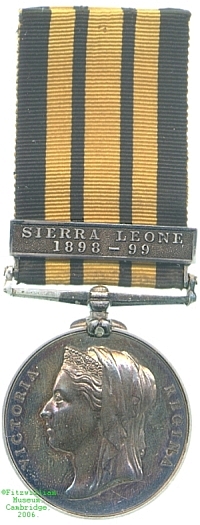East and West Africa Medal, 1899
Peace-keeping operations in the British possessions in Africa, as anywhere else, required a large number of small campaigns, several of which, from 1892 until 1900, were considered to merit this medal, which in terms of design is a continuation of the Ashantee War Medal. Recipients who held that medal already were therefore awarded only extra clasps.
British interests in Sierra Leone had a rather unusual history, as the first colony in the area, Freetown, was established as a utopian new home for liberated slaves. Not only did these ex-slaves revolt at least once, but as the number of quasi-repatriated settlers in the country grew, the indigenous peoples of the area rose up several times in defence of their diminishing control of their homeland. In 1898 and 1899 a British military force was active on what was then called the Brempe River and around Sherboro Island in order to quell such a revolt.
This medal was awarded to Private Momo Duko, of the West African Rifles, one of the soldiers involved in that campaign (very few of these medals were awarded to Europeans). Lester Watson acquired the medal at some point before 1928.

